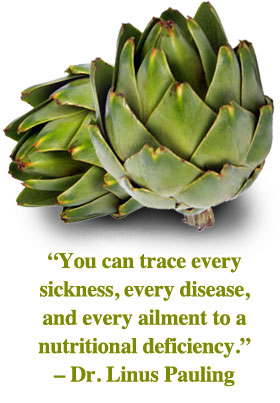Cultured & Fermented Vegetables
Fermented cultured vegetables have been used for healing purposes for thousands of years. Fermented vegetables have large amounts of potent active, living, friendly aerobic bacteria strains; the most popular being lactobacillus. During the culturing process, lactic acid is produced which acts as a natural preservative for the foods which are fermenting, ensuring the foods do not rot and putrefy. The starches and sugars in the vegetables are converted into lactic acid which helps in the growth of aerobic friendly bacteria. In the beginning stages of introducing cultured foods, you may experience increased gas and detoxification. This is expected and is a welcomed good sign for it represents cleansing. These symptoms will subside once your body becomes more balanced.
Why eat raw fermented vegetables?
- Excellent source of Vitamin C, lactobacilli, and other nutrients
- Contains cancer fighting compounds
- Excellent for flu prevention
- Regulates gastrointestinal problems (diarrhea, constipation, ulcers, intestinal mucosa, etc)
- Helps bronchitis and other respiratory conditions
- Helps with anemia
- Helps with headaches
- Neutralizes the effects of alcohol consumption (hangovers)
- Cleanses the liver
Serving suggestions: 2-4 tablespoons about 3x to 5x per week
 Sauerkraut
Sauerkraut
4 heads of organic white or purple cabbage
5 organic carrots (optional)
3 cloves of garlic
1 organic apple
1 lemon
1 Tablespoon Himalayan salt or sea salt
Directions:
Cut the cabbage, carrots and apple into small pieces with a knife so it will go into the cuisinart food processor comfortably. Shred the cabbage, carrots, apple and garlic into small pieces and remove into a bowl.
Take 2 cups of the mixture and add it to your blender. Add the lemon juice and salt to the blender and blend it into a liquid which you will be pouring into the air tight crock full of shredded vegetables. Take all the shredded vegetables in the bowl and pack them into your air tight seal container.
Pour the liquefied mixture from the blender into the container and pack the I ingredients down as hard as you can into the container any way you can. I like to use a clean wet towel and my hand.
Press the ingredients down with a cabbage leaf leaving the large cabbage leaf as the “cover” ontop of the shredded vegetables. Place lid on top of the container and let the process begin. Leave a small space between the level in which the vegetables come to the top and the top of the container for the fermentation process has a tendency to expand and grow as the vegetables culture
Make sure the temperature is between 70 and 78 degrees for ideal and predictable results. You should be able to see the fermentation bubbles from the outside of the container if you are using glass. You will also be able to smell the process.
Allow your vegetables to culture for 3 to 4 days before removing them from their container and placing them in refrigeration. Your fermented vegetables will last up to 8 weeks before the go bad. You will know they have gone bad when the color gets very dull or if you see visible mold growing.
 Kimchee
Kimchee
4 heads of white asian, white or purple cabbage
3 large organic carrots
1 8 inch piece of raw fresh peeled ginger
2 White daikon radishes
5 scallions
3 pieces of fresh garlic
2 Tablespoons of cayenne powder
1 Tablespoon of Himalayan salt or sea salt
½ lemon juiced
Directions:
Cut the cabbage, carrots, daikon, scallions, ginger into small pieces with a knife so it will go into the processor comfortably. Shred the cabbage, carrots, daikon, scallions, ginger and garlic into small pieces and remove into a bowl.
Take 2 cups of the mixture and add it to your blender. Add the cayenne pepper, lemon juice and salt to the blender and blend it into a liquid which you will pour into the shredded vegetables. Take all the shredded vegetables in the bowl and pack them into your air tight seal container.
Pour the liquefied mixture from the blender into the container and pack the ingredients down as hard as you can into the container any way you can. Press the ingredients down with a cabbage leaf leaving the large cabbage leaf as the “cover” on top of the shredded vegetables. Place lid on top of the container and let the process begin. Leave a small space between the level in which the vegetables come to the top and the top of the container for the fermentation process has a tendency to expand and grow as the vegetables culture
Make sure the temperature is between 70 and 78 degrees for ideal and predictable results. You should be able to see the fermentation bubbles from the outside of the container if you are using glass. You will also be able to smell the process. Allow your vegetables to culture for 3 to 4 days before removing them from their container and placing them in refrigeration.
Your fermented vegetables will last up to 8 weeks before the go bad. You will know they have gone bad when the color gets very dull or if you see visible mold growing.
How to Make Lacto-Fermented Vegetables without Whey
(retrieved from www.nourishingmeals.com, Sept 22, 2012)
Traditionally lacto-fermentation was used to preserve the harvest and store vegetables for the winter. If you have a garden full of cabbage, cauliflower, beets, carrots, and green beans and don't know how to store them all, consider making a few batches of lacto-fermented vegetables. These veggies can be stored in your refrigerator for months....if they last that long!
Lacto-fermented vegetables provide a viable source of probiotics (at a cost well below most supplements) to heal and maintain a healthy gut. These beneficial microorganisms attach to receptors in our guts that send a signal to the immune system that says everything is okay, no need to overreact to foods and other things entering the gut, let's keep everything calm. If you are dealing with multiple allergies, chances are your gut is out of balance and is in need of a daily dose of beneficial microorganisms. These crispy, sour, salty vegetables are highly addicting and an easy, economical way to maintain a healthy gut.
Lacto-Fermented Vegetables
We've tried fermenting all types of different vegetables. We have fun creating different flavors, some spicy and some not. Our current flavor addiction is beet-basil-dill-carrot-garlic. All of these vegetables combined in one jar is out of this world good....even if you thought you didn't like beets! I have tried using a salt brine made up from anywhere between 1 to 2 tablespoons of sea salt per 2 cups of water. I find that 2 tablespoons is too salty and slows down fermentation, so use anywhere between 1 and 1 1/2 tablespoons. It is very important that you use filtered water for all fermentation. Chlorine in water is great for keeping our water supply clean but not so good for allowing beneficial bacteria to grow and not so good for our guts and overall health.
1 glass quart jar with a plastic lid
1 to 1 1/2 tablespoons sea salt
2 cups filtered water
Any Combination of Raw Organic Vegetables:
chopped cauliflower
chopped beets
chopped carrots
chopped green beans
chopped bell peppers
sliced radishes
sliced daikon
sliced cucumbers
chopped turnips
chopped broccoli
chopped kale
chopped onions
chopped green onions
chopped garlic
cabbage leaves (for the top)
Any Combination of Herbs and Spices:
dried chili peppers
black peppercorns
bay leaf
fresh dill
fresh basil
fresh tarragon
fresh mint
sea vegetables (arame or hijiki) - use less salt if using these
First dissolve your sea salt in water in a glass jar or 2-cup glass measure. Then place you favorite combination of vegetables into a quart jar (you can use a larger cylindrical jar or ceramic crock instead, just double or triple the salt brine keeping the same ratio of salt and water). Add a few layers of herbs and spices too. I prefer to keep the peppercorns in the first layer, on the bottom of the jar, so they don't float to the top. Make sure you leave about an inch from the top of the jar.
Then cover with your salt brine, leaving about an inch to a half inch from the top. Fold a small cabbage leaf and press it into the brine so the water floats above it and the vegetables are completely submerged. Cover with a plastic lid (it is best not to use metal as the salt and acids can corrode it, though I have used them occasionally if that is all I have). Don't screw the lid on too tight. You want some space for gasses to release. You should see a bit of bubbling and some liquid possibly dripping out after about day three, depending on the heat level in your home. I like to place my jars into some sort of container, like a rectangular Pyrex dish, to catch any drips. Set your jars in an undisturbed place in your kitchen out of direct sunlight. I like to store mine on top of my refrigerator.
You can taste the veggies after about five days to see how soured they are. I prefer to let mine ferment for about 7 to 8 days in the winter and 5 to 6 days in late summer. I have also let them ferment for 10 or more days. Just experiment, there is no exact science with fermentation. After your veggies are soured to your liking, remove the cabbage leaf, and place the jar (or jars) into your refrigerator where they will store for months.
Use your vegetables to top cooked quinoa, beans, and chopped leafy greens. Serve them atop grilled fish or chicken. Serve them with scrambled eggs for breakfast. I like to add them to salmon or chicken salads made with mayonnaise. And try to restrain yourself from eating the whole jar in one sitting....it may be a little too much salt all at once! You can also whisk some of the leftover brine with olive oil, a squirt of dijon mustard, and a dash of honey for a probiotic salad dressing!





